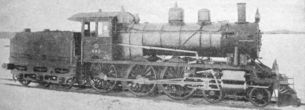4-6-0
2008/9 Schools Wikipedia Selection. Related subjects: Railway transport

In the Whyte notation, a 4-6-0 is a railroad steam locomotive that has a two-axle leading truck followed by three driving axles. This wheel arrangement became the second-most popular configuration for new steam locomotives in America in the mid-19th century. In the United States this type is commonly called a Ten-wheeler.
The equivalent UIC classification is 2'C.
United States

The first 4-6-0 built in America was the Chesapeake. It was built by Norris in March 1847 for the Philadelphia and Reading railroad. There is still a question as to who was the original designer of this type. Many authorities attribute the design to Septimus Norris, but in a paper written in 1885, George E. Sellers attributes the design to John Brandt.
Brandt worked for the Erie Railway between 1842 and 1851. The Erie's own management didn't feel it in their best interests to pursue construction, so Brandt showed the design to Baldwin and Norris. Baldwin was similarly unimpressed, but Norris liked the idea. According to Sellers, James Millholland, of the Reading, saw the 4-6-0 design as well and ordered one from Norris for the Reading. However, Sellers may have misrecalled a few of the specifics as Millholland did not work for the Reading until 1848, a year later. Also, Sellers lists the first 4-6-0 constructed as the Susquehanna, which was the Erie railroad's first 4-6-0.
The attribution to Septimus Norris lies in a patent that many sources cite for this locomotive type that was filed in 1846. However, such a patent has not yet been found in searches at the USPTO. Septimus Norris did file a patent in 1854 for running gears, and the patent application showed a 4-6-0 in the drawing. Norris' wording in the 1854 patent was vague in regard to the 4-6-0 wheel arrangement; the filing didn't specifically claim invention of the 4-6-0 type.
A few days after William Norris completed the Chesapeake, Hinkley completed their first 4-6-0, the New Hampshire for the Boston and Maine Railroad. The first 4-6-0 from Rogers was the previously mentioned Susquehanna for the Erie Railroad.
Baldwin's first 4-6-0 did not appear until 1852. Through the 1860s and into the 1870s, demand for the 4-6-0 grew as more railroad executives switched from purchasing a single, general-purpose type of locomotive (at that time, the 4-4-0), to purchasing locomotives for specific purposes. Both the Pennsylvania Railroad and the Baltimore and Ohio were early adopters of the 4-6-0, using them for fast freight and heavy passenger trains.
United Kingdom
The first 4-6-0 to be introduced to Britain was the Highland Railway Jones Goods Class in 1894, but the type later mostly found use as mixed traffic and passenger locomotives, British freight trains being generally too slow to require a four-wheel leading truck.


